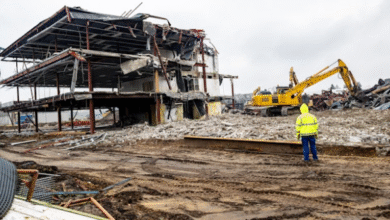How BIM Automation is Transforming the Way Builders Approach Projects

In the construction, efficiency, accuracy, and collaboration are crucial to delivering successful projects. Builders face numerous challenges, from managing complex designs to ensuring timely project completion while staying within budget. Traditional methods of project management and design have often led to delays, errors, and increased costs. However, Building Information Modeling (BIM) automation is changing the game.
BIM automation is reshaping how builders approach construction projects, enabling them to streamline processes, improve accuracy, and enhance collaboration. With its ability to integrate various project elements into a single, unified model, BIM offers a powerful tool for managing design, planning, and execution. The use of automation within BIM takes this further, reducing manual tasks, increasing efficiency, and helping teams stay ahead of potential issues.
In this post, we will explore how BIM automation is revolutionising the construction industry. We’ll discuss the key benefits it brings to builders, the process improvements it enables, and how it helps in managing projects more effectively. Find out more about how these advancements can improve your projects.
What is BIM Automation?
Building Information Modelling (BIM) has evolved significantly in recent years. While traditional BIM focuses on creating detailed 3D models of buildings, BIM automation adds another layer by introducing automated processes within the modelling and management of projects. This involves the use of software tools and algorithms that automate repetitive tasks, from data entry and coordination to scheduling and cost management.
BIM automation integrates design, construction, and operational processes, enabling teams to work with a centralised, updated model throughout the project lifecycle. This automated approach not only speeds up workflows but also ensures that all stakeholders are working with the most accurate and current data.
Benefits of BIM Automation for Builders
BIM automation offers builders enhanced efficiency, improved collaboration, and greater accuracy throughout the project lifecycle. By automating key processes, builders can reduce errors, save time, and manage resources more effectively. Here are some of the benefits:
1. Increased Efficiency
One of the most significant benefits of BIM automation is its ability to enhance efficiency across various stages of a project. Builders no longer need to manually enter data into multiple systems or recreate designs. Automated processes help streamline these tasks, reducing the time required for design iterations and project updates.
For example, automated clash detection tools in BIM can identify potential conflicts in the design before construction begins, eliminating the need for costly rework. This ensures that the project moves forward smoothly and within the allocated timeframe.
2. Enhanced Collaboration
Collaboration is essential to the success of any construction project, but managing communication between multiple teams can often be difficult. BIM automation makes it easier for architects, engineers, contractors, and subcontractors to work together by providing a single platform for project information. All team members can access real-time updates, track progress, and share critical data, ensuring alignment throughout the project.
Automation also helps manage project schedules and tasks more effectively. Instead of relying on manual updates and meetings, the BIM system can automatically notify teams about upcoming milestones or potential delays, keeping everyone in the loop and on track.
3. Improved Accuracy and Reduced Errors
Construction projects are inherently complex, and even small mistakes can have significant consequences. Traditional project management methods often lead to errors, whether it’s inaccurate measurements, missing details, or miscommunications between teams. BIM automation minimises these risks by automating repetitive tasks and providing built-in error-checking tools.
For instance, automated design validation ensures that all components of the building comply with regulatory standards and design specifications. This reduces the chances of costly mistakes and ensures that the final product meets all necessary requirements.
4. Better Resource Management
Managing resources efficiently is one of the biggest challenges builders face. BIM automation helps optimise resource allocation by providing real-time insights into material usage, labour requirements, and equipment needs. This allows project managers to make informed decisions, reducing waste and ensuring that resources are used efficiently.
By automating the tracking of inventory and project materials, BIM helps builders avoid overordering or underordering supplies. This leads to cost savings and ensures that the project stays on schedule without delays caused by material shortages.
How BIM Automation Improves Project Management
BIM automation enhances project management by streamlining scheduling, cost estimation, and risk management. It provides real-time insights, ensuring projects stay on track and within budget. Here is how BIM automation improve project management:
1. Streamlined Scheduling
Time is money in construction, and delays can quickly escalate costs. BIM automation can significantly improve scheduling by integrating task management into the model. Automated scheduling tools analyse the project’s timeline and dependencies, offering insights into the most efficient path forward.
With BIM, construction managers can track progress against the schedule in real-time, enabling them to make adjustments if delays arise. This predictive capability ensures that projects stay on track, avoiding common scheduling pitfalls such as waiting for materials or delayed tasks.
2. Accurate Cost Estimation
Estimating costs accurately is a critical part of construction project management. With BIM automation, builders can generate more accurate cost estimates by leveraging detailed, real-time data. Automated cost estimation tools can pull data directly from the 3D model, providing accurate material quantities and labour requirements, which helps avoid cost overruns.
Furthermore, by automating the cost tracking process, BIM allows project managers to compare actual expenditures to the estimated budget, providing them with valuable insights into where costs are deviating and why. This level of accuracy helps builders make adjustments in real time, avoiding budget blowouts.
3. Risk Management
Managing risk is a crucial part of every construction project. BIM automation helps identify potential risks early by analysing project data in real-time. Automated tools can predict risks related to delays, material shortages, design conflicts, and safety concerns, allowing builders to address these issues before they become serious problems.
With BIM, project managers can also simulate different construction scenarios to understand how changes might impact the timeline, costs, and resources. This predictive capability enables builders to make more informed decisions, improving project outcomes and reducing the likelihood of costly mistakes.
Real-World Examples of BIM Automation in Action
BIM automation is already transforming the construction process in several innovative ways. From virtual construction simulations to efficient prefabrication, these real-world applications showcase how builders are leveraging BIM to enhance project outcomes and reduce costs.
1. Virtual Construction
Virtual construction is a powerful example of how BIM automation is changing the way projects are managed. Builders can use BIM to simulate the construction process before breaking ground, identifying potential issues and conflicts in the design early. This allows them to plan better and avoid costly errors once construction begins.
Virtual construction also allows teams to explore different construction scenarios, such as testing different building materials or construction techniques. By automating these simulations, builders can make better decisions without the risk of real-world testing.
2. Prefabrication
With BIM automation, prefabrication has become more efficient. Automated design tools allow builders to design and fabricate components off-site, ensuring that they fit seamlessly when assembled on-site. This approach reduces construction time and improves the quality of the final product by minimising errors and on-site rework.
Prefabrication also helps optimise material usage, reducing waste and ensuring that resources are used efficiently. By automating this process, builders can speed up construction while maintaining high-quality standards.
The Future of BIM Automation
As technology continues to evolve, the role of BIM automation in construction is expected to expand further. In the future, we may see even more advanced tools that incorporate artificial intelligence (AI) and machine learning to improve decision-making and automate more complex tasks.
For example, AI could be used to optimise project schedules by predicting the most efficient sequence of tasks based on past project data. Similarly, machine learning could help BIM systems learn from previous mistakes and suggest improvements to the design or construction process.
The ongoing development of BIM automation will continue to shape the construction industry, providing builders with even more powerful tools to manage projects effectively, reduce costs, and improve collaboration.
Conclusion
BIM automation is undoubtedly transforming the construction industry by enhancing efficiency, collaboration, accuracy, and resource management. As technology evolves, the benefits of BIM automation will only continue to grow, helping builders tackle the challenges of modern construction projects more effectively.
By leveraging BIM automation, you can streamline your workflows, reduce errors, and ensure that your projects are completed on time and within budget, making it a powerful tool for any builder looking to stay ahead in the competitive construction landscape.




